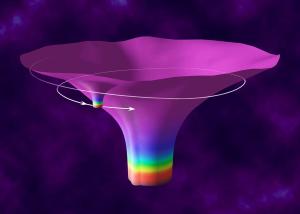Post
Fuzzy Wuzzy
5 September 2013
 Don Davis
Don DavisAccording to general relativity, a black hole has three measurable properties: mass, rotation (angular momentum), and charge. That’s it. If you know those three things, you know all there is to know about the black hole. If the black hole is interacting with other objects, then the interactions can be much more complicated, but an isolated black hole is just mass, rotation and charge.
In general relativity this is known as the no-hair theorem. The basic idea of the no-hair theorem is that the material properties of any object (referred to as “hair” because a physicist named John Wheeler once coined the phrase “a black hole has no hair”) become unmeasurable (hence unknowable) as the object collapses into a black hole.
On the surface this seems fairly reasonable. If a neutron star collapses into a black hole, for example, all the neutrons and their interactions become trapped inside the black hole’s event horizon when the black hole forms. The same would be true for an object that was lopsided (say with a mountain range on one side). As it collapses into a black hole, any irregularities would be squashed flat as it approaches the black hole limit.
But there are also difficulties with the no-hair theorem. For one, even though it’s referred to as a theorem, it has never been proved in general relativity. So it really should be called the no-hair hypothesis. There have been lots of demonstrations that the theorem is reasonable, and computer simulations tend to agree that black holes stabilize to a structure defined by mass, rotation and charge. But none of these reach the level of proof.
Then there is the problem that if a black hole really is just defined by mass, charge and rotation, then it has no temperature, and that means that its entropy is zero. This violates the principles of thermodynamics. Of course when we try to include quantum theory into our black hole description we know that black holes do have a temperature. In Hawking’s theory, the temperature of a black hole depends upon its mass, so even a Hawking black hole would be definable by mass, rotation and charge. It’s possible that the no-hair theorem is valid even for a quantum black hole.
But there is a more subtle mystery that hides within the no-hair theorem, because it would seem that a black hole is much simpler than other massive objects such as planets, stars and the like. If you think about an object like the Sun, it has a certain chemical composition, and it’s giving off light with different wavelengths having varying intensities. There are sunspots, solar flares, convection flows that create granules, and the list goes on. The Sun is a deeply complex object that we have yet to fully understand. And yet, if our Sun were compressed into a black hole, all that complexity would be reduced to mass, rotation and charge. So what happens when a complex object like a star collapses into a black hole? Where does all that complexity go?
In physics we refer to that complexity as the physical information of a system. According to quantum theory, physical information is never lost, but according to general relativity and the no-hair theorem, physical information that enters a black hole is lost forever. This contradiction is known as the black hole information paradox, or sometimes the firewall paradox. Now you might think that the easy answer is just to presume the no-hair theorem is wrong.
But it’s not that simple, and if we started exploring that paradox, things would get a bit hairy.